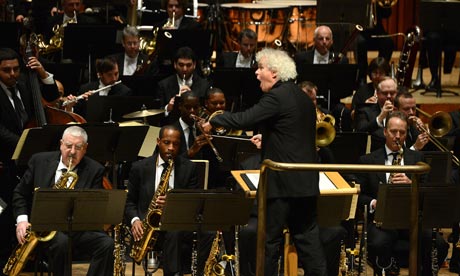
It's not often that one sees the London Symphony Orchestra sharing the platform at all – even with such a distinguished ensemble as the Jazz at Lincoln Center Orchestra. But these were the forces assembled under the baton of Simon Rattle for the first UK performances of Wynton Marsalis's Swing Symphony, given as the end point of the New York-based group's Barbican residency.
This is Marsalis's Third Symphony, premiered in Berlin in June 2010. It's a big piece, around an hour in length, charting in a highly personal review the origins and evolution of swing rhythms in admiring tributes to ragtime, the Charleston, bebop, mambo and several other genres.
The result provided a diverse and vibrant listening experience, graced here by some dazzling solo and ensemble work from Marsalis and his JLCO players, with especially vivid contributions from Joe Temperley and Sherman Irby, among others. But solos were distributed, too, throughout the LSO's principals, with Rattle motivating a highly interactive scheme, while allowing the JLCO soloists, regularly treated as an orchestra within an orchestra, maximum freedom to take off into the blue – which they duly did. Throughout, the orchestral writing proved inventive and often brilliantly effective, with beautifully spaced string textures shot through with rampant interventions from the brass and some debonair splashes of percussion, the whole finally coming gently and delicately to rest on a breezy downbeat sigh.
Rattle, who led the piece's Berlin premiere, seemed finely attuned to its idiom – perhaps more so, surprisingly, than he had been with Rachmaninov's Symphonic Dances, with which he and the LSO began the evening. The lightly modernist touches that infiltrate this mordantly nostalgic sequence should spice up, rather than obliterate, its heady late-Romantic glow. But Rattle's overly brash approach, occasionally bordering on the strident, robbed Rachmaninov's dark-hued visions of some of their essentially enigmatic ambiguity.

